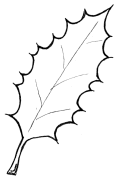Some plants use various forms of physical protection:
| Hawthorns use thorns to discourage browsing
by herbivores such as deer. |
 Thorns on hawthorn |
 Spines on cactus |
Cactus have spines to protect their succulent
stems, and thus their precious water supplies. |
| Hollies bear spines on the margins of their
leaves as a deterrent to would-be browsers. |
 Spines on holly |
 Prickles on rose |
Rose prickles (commonly, though inaccurately,
referred to as thorns) deter grazing animals, and their downward curve prevents small
animals from climbing the stem. |
Many plants have fuzzy or hairy leaves—the
hairs are actually specialized epidermal cells—that protect the plant from insect
attack. (The fuzzy texture may also discourage grazing.)
Perhaps the simplest example of physical protection is the
bark of trees. Bark is made up of a thick layer of dead cells that forms a barrier against
water loss and invasion by insects or disease.
A key component of physical protection is rapid wound
healing. If a plant’s epidermis is injured, water loss and invasion by insects and
disease organisms can rapidly weaken the plant. Herbaceous plants respond to any break in
the epidermis by collapsing the cells along the surface of the wound, effectively sealing
it. Waxy substances are then deposited to further seal the wound. Woody tissues respond to
injury by forming a callus, which consists of a mass of undifferentiated cells arising
from cell division near the wound surface. Over time cork encroaches from the area
surrounding the wound, and may completely cover it. Cork is a secondary tissue, formed by
the cork cambium. It is part of the outer bark that replaces the epidermis in woody plant
parts.
|
|
 A Prickly Subject.
So what’s the difference between a thorn and a
prickle?
� A thorn is a
rigid, sharp-pointed outgrowth from the wood of a stem, and, because of its internal
structure, is considered a modified stem. Because they arise in leaf axils in the position
of axillary buds, thorns are usually regularly spaced.
� Prickles are
similar to thorns, but they originate from the bark or epidermis of a plant rather than
from the wood. They are usually irregularly spaced, and can be removed without damaging
the stem.
� A spine is a
modified leaf part. Many cactus have spines, and the points on holly leaves are spines. |
 Pruning Protocol. When you prune a tree or shrub, you are creating an open wound.
Though the standard recommendation used to be to paint over any large cuts with a special
sealer, recent research shows that this does not speed healing and may even slow the
process.
However, you can help the healing process by
pruning branches close to the branch collar—the swollen area where the branch meets
the trunk—without actually cutting into the collar. This type of cut will allow the
plant to most quickly form protective callus, and eventually cork, layers.
Don’t leave a long branch stub; if you do, the
cork tissue will not grow over and protect the protruding section. |
|
|
|